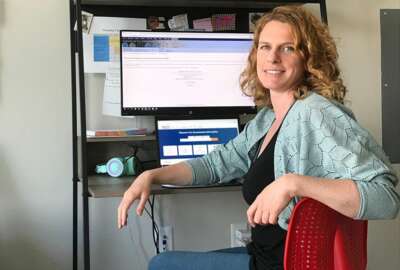Insight by Carahsoft and Zoom
The evolution of the hybrid work environment depends on unified communications
Matt Mandrgoc, the head of Public Sector at Zoom, said there are several considerations agencies must keep in mind, including legacy technology and complexity as...
Insights from the series, Innovation in Government.
This fall more federal employees will return to the office. Every week it seems another agency is drawing the line of how often employees must be in person and how often they can work remotely.
No matter where that line in the sand is drawn – four days a pay period for some agencies and six days for others seems to be the trend – one thing is definitely clear the hybrid workplace is here to stay.
And despite agencies, and the private sector, being three years into this hybrid work environment, agencies continue to experience complexity in their technologies to support their workforce and their culture to
As traditional office space evolved into a hybrid working environment, the need for new technology that can create that flexibility for cultural change remains a key factor in an agency’s current and future success.
As agencies continue to adapt to the needs of their workforce and their customers, they also must innovate, evolve and ensure proper cybersecurity controls are in place.
Matt Mandrgoc, the head of Public Sector at Zoom, said there are three considerations agencies must keep in mind as they continue to evolve in the hybrid work environment.
The first is forced technology, where employees are required to use certain tools and that impacts their productivity.
Second is adding complexity to the user’s ability to work across the agency or among agencies because of technology that doesn’t integrate or impacts productivity.
And third, the continued reliance on legacy technology that impacts users, security and adds complexity.
“As the government continues with IT modernization, they need to look at how their systems allow these individuals to work in the hybrid environment. We’ve seen one agency that was spending almost $5 million-to-$7 million just for equipment that was sitting there because as people were working in a hybrid environment, it didn’t scale. Now as the government is making these decisions, they have to look at total cost of ownership,” Mandrgoc said on the Innovation in Government show sponsored by Carahsoft. “The other issue is the recruitment, retaining workers and the productivity of the of the government end user. As you look across these executive orders around customer experience, it really allows for them to take a look at this much differently. How do you start to look at, understand and get input from these end users, bringing it back and utilizing the technology or the solutions or the platform to enable them to do their job in this hybrid environment?”
Strive for a unified communications platform
Agencies have to evaluate all their technology investments and analyze what drives up productivity, what may be an inhibitor to productivity and what easily integrates across the environment.
Mandrgoc said agencies also have to be aware of supporting two different, and not necessarily equal, technology environments – one for the leadership and one for everyone else.
He said agencies should strive to create a unified communications platform that serves all their needs whether in the office or remotely. There are five factors that must be part of any communications platform.
“The first is simplicity, being able to assemble it and it works. We saw this happen with the Department of Treasury when it had to pull lawmakers together to make some decisions on the economy. We saw them being able to quickly move and pivot around the end user,” Mandrgoc said. “The second important piece is around scalability, being able to scale quickly across an organization, being able to add people and move around events or meetings. That scalability is important without having to go through gyrations and gyrations of work to put that together.”
The third piece of this unified communications platform is innovation.
Mandrgoc said having the ability to easily move into and out of breakout rooms or and ensuring the accessibility of access for all end users.
“The fourth is around extensibility, being able to leverage investments that you’ve already made. A great example is in a FedRAMP environment and what we’ve done around with ServiceNow, which is to be able provision phones automatically, where it was a manual process before. Now it cuts down and takes away that manual process and allows that IT team to be more productive as they’re helping their end users, even getting into a self-service component to be able to automate a process that was manual before,” he said. “The last is around security. When you start to dig further into security, it is not just what the certifications people have, but really down to how do you have that same capability around an administrator level? Will you control that down at the user level? Security really moves to the forefront on that as well.”
Accessibility becoming more important
Mandrgoc added the overarching factor agencies need to consider when developing a unified communication platform is the total cost of ownership. He cautioned agencies against believing they are getting tools or capabilities for free as part of a package.
He said there is always a cost to integrate with other technologies and platforms as well as the challenge of guarding against shadow IT.
“A lot of when at unified communications, and especially in the hybrid environment, people have been so focused around what that accessibility looks like in the office. But how does it look like from home? How do we really do a better job in industry of highlighting what we’re doing around accessibility? A lot of times decisions get made on technology and accessibility sometimes becomes an afterthought. Here’s the opportunity now to say for industry to come forward and highlight what we’re doing,” he said. “Accessibility is not a checkbox. It’s something that’s evolving. There’s constantly there’s things we’re doing around movement in a meeting. There’s all kinds of different capabilities out there that we have industry really need to highlight more for our individuals and agencies.”
To learn more from the Innovation in Government series, click here.
Listen to the full show:
Copyright © 2025 Federal News Network. All rights reserved. This website is not intended for users located within the European Economic Area.
Related Stories
Featured speakers
-

Matt Mandrgoc
Head of U.S. Public Sector, Zoom
-

Jason Miller
Executive Editor, Federal News Network
Upcoming Events
Related Stories
Top Stories

Matt Mandrgoc
Head of U.S. Public Sector, Zoom
As Head of U.S. Public Sector, Matt leads Zoom’s U.S. Federal, State and Local governments and Education business segments. He has led Zoom for Government during a period of historic growth from launch to ubiquity. Matt’s leadership has allowed Zoom to provide frictionless communication and collaboration capabilities and continuity of operations during a time unprecedented impact to the Federal and Public Sector mission. Matt has over two decades of experience leading Federal and Public Sector units at Extreme Networks, Check Point Software Technologies, and Cisco.

Jason Miller
Executive Editor, Federal News Network
Jason Miller has been executive editor of Federal News Network since 2008. Jason directs the news coverage on all federal issues. He has also produced several news series – among them on whistleblower retaliation at the SBA, the impact of the Technology Modernization Fund and the ever changing role of agency CIOs.






